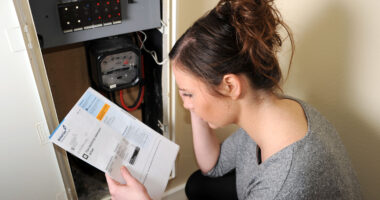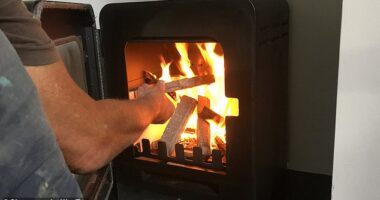HE is on a mission to help our pets . . . and is here to answer YOUR questions.
Sean, who is the head vet at tailored pet food firm tails.com, has helped with owners’ queries for ten years. He says: “If your pet is acting funny or is under the weather, or you want to know about nutrition or exercise, just ask. I can help keep pets happy and healthy.”
Q) BONNIE, our 11-month-old Romanian rescue dog wakes me up barking at 5am, even though she’s had a late-night walk.
I always take her out at 6am before I go to work. If my daughter comes down to let her out, she will still sit and bark for me.
My daughter said it could be separation anxiety, but I don’t want Bonnie to sleep upstairs as my grandchildren stay over sometimes.
DONNA GIBSON Shepshed, Leics
SEAN SAYS: Do you give in to her barking every morning? If so, she has learned a great way to kick-start the day. One approach to this is to ignore the barking until it stops.
Dogs and other animals go through an “extinction phase” with a behaviour if they find it no longer gets a desired effect. After a few mornings of no response, it should wear off.
Take care not to reward it during this phase though, as you might undo your hard work.
If it’s anxious behaviour around separation in other circumstances, too, I suggest a qualified animal behaviourist.
Got a question for Sean?
SEND your queries to [email protected].
Q) MY cat Alfie is a food thief. Given the slightest chance she will gobble any scrap of food.
We keep the kitchen door closed and everything put away, but when you’re cooking and let your guard down for a second, she springs.
We once caught her with her head in a trifle.
Another time she scoffed part of a Sunday roast that was resting, as one of our young kids left the door open. She even does it to the neighbours. Needless to say, she then turns her nose up at her dinner.
BRENDA SWIFT, Leeds
SEAN SAYS: I need a few more crucial details. Firstly, what age is she and has she always been like this or is it a recent development?
If recent, then I suspect there could be an underlying medical condition at play, rather than it just simply being Alfie’s personality.
Secondly, I’d love to know more about Alfie’s weight. Have a look at how to “body-condition score” your cat to check this.
Lastly, what kind of diet is Alfie on? I’d recommend one that is balanced, with high-quality ingredients and formulated by a qualified animal nutritionist.
My advice is a vet check, and just keeping food out of bounds, apart from her specific food.
Q) MY Persian house cat Molly has very long claws.
How can I get her to wear them down? Or should I take her to the vet?
ALEX WHITE, Glasgow
SEAN SAYS: Apart from giving her access to plenty of scratching posts and various surfaces to keep her claws in trim, you’ll probably have to learn to clip them yourself.
The problem with clipping cats’ claws is they split and grow back very quickly once the outer sheath comes off.
Your vet team will be able to assess this, and whether Molly is in need of a manicure.
Q: OUR greyhound Woodstock is terrified of fireworks. What can I do ahead of Bonfire night?
ANDREW BROWN, Romford, East London
SEAN SAYS: Woodstock isn’t the first and certainly won’t be the last scaredy cat or dog to go running to his bed when fireworks kick off.
You can’t start early enough preparing anxious pets for this season.
Use a process of noise desensitis-ation to gradually get pets used to the sounds at slowly increasing volume and frequency. It takes a lot of effort and time, but it’s worth it.
Start now, but make sure not to overwhelm him.
And when it comes to firework nights kicking off, make Woodstock a lovely, quiet and dark den to retreat to. Lots of my other top tips for this are on our tails.com blog.
Star of the week
LEO the Labrador is a four-legged bookworm who has inspired a series of children’s books.
The eight-year-old Pets As Therapy volunteer lives with writer Parnita Senjit in Croydon, London, and helps kids in schools as a reading dog.
Parnita has now written two books.
The Chosen One is all about Leo when he was a puppy, and The Journey Begins follows Leo when he leaves his mum and litter mates.
Parnita, 48, said: “Leo loves being around children and helps them to relax.
“The books are so he can help children all over the world.”
Win: Puppy pack
PUPPY training app Zigzag, is celebrating a milestone of training more than 120,000 pups.
So it is offering one reader the chance to win goodies worth £250.
The prize features a personal online training session, a Zigzag anxiety wrap – designed to comfort your dog from loud noises, perfect for November 5 – and a year’s free app subscription.
For a chance to win, send an email headed ZIGZAG APP to [email protected] by October 30. See https://zigzag.dog. lT&Cs apply.
Secrets of sleeping positions
THE way cats and dogs sleep can tell you how they feel, experts say.
Boffins from brand Petsafe and retailer and community Your Dog’s Club have revealed the top five pet sleeping positions and what each means.
Behaviourist Alyssa Ralph said: “It’s always good to remember that however your pet sleeps, it’s good to give them space.”
The top five cat positions are . . .
- The lap curl: Where your cat tucks her tail around her body and curls up. She may feel insecure or want to keep warm.
- Superman: When your cat stretches out – often across the soaf – like a flying superman, it reveals they are deeply content.
- Tum cat: On their back with legs in the air means they trust you.
- Sphinx: Laying upright and alert with paws tucked under the body like a Sphinx means they are dozing, but ready to pounce.
- The Gandalf: Sitting with eyes half closed, like the Tolkien character, can mean they are grumpy.


The top five dog positions are . . .
- Legs Akimbo: Sprawled on their back, with legs in the air means that they are as relaxed as can be.
- The Starfish: Lying on their side with legs stretched says they feel totally safe and secure.
- The Cuddle Bug: Lying on your lap or touching you could be a sign of affection or that they are slightly insecure.
- Doggy Donut: Curled in a ball can mean they are keeping warm – so check their sleeping area isn’t chilly. They can also be uncomfortable.
- Sleeping Sphinx: If they tuck their feet up under their body, like a Sphinx, they are having a light nap and are content.












